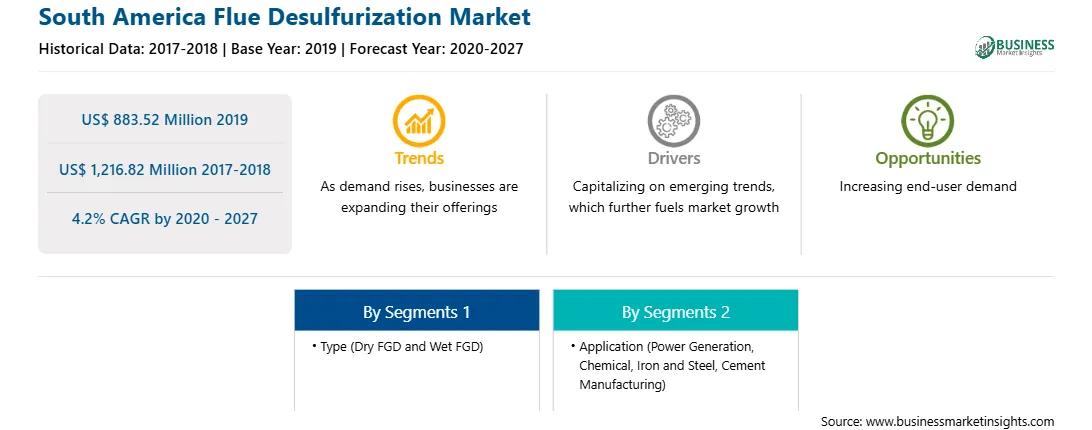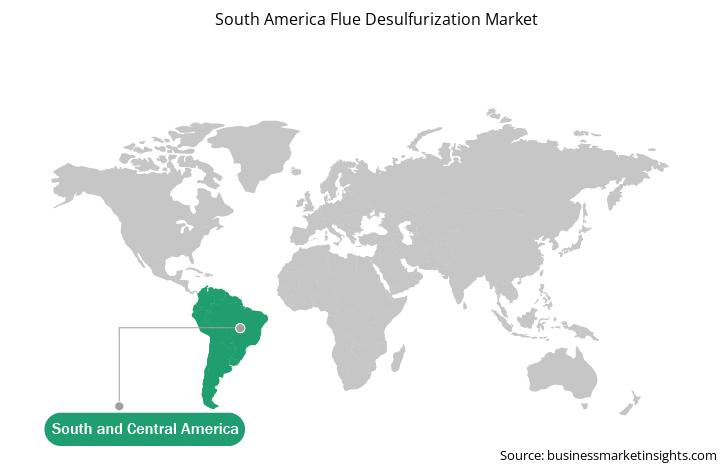The South America flue gas desulfurization market is a highly fragmented market with the presence of considerable regional and local players providing numerous solutions for companies investing in the market arena. The continuous developments have had a positive impact on Brazil and Argentina's economy that has advanced to a large extent. The increase in population and continuous advancement in the end-use industries such as, power generation, chemical, cement manufacturing, and others have had a positive impact on the flue gas desulfurization market of Brazil and Argentina that has advanced to a large extent. One of the major end user industry that offers ample amount of opportunities for the flue gas desulphurization market is the cement manufacturing industry. The cement industry growth in South America varies across the region. The leading emerging markets such as Argentina and Brazil, account for the largest share in the regional cement production. Other key cement markets in the region include Bolivia, Colombia, Cuba, Peru, Venezuela and Uruguay. To increase the installed cement capacity in Bolivia, both the government and private companies have carried out a substantial series of investments for the modernization and expansion of their plants. Increasing domestic demand through the investment of social housing programs, public infrastructure works and from the private sector, along with the construction of buildings and urbanizations are stimulating the growth of cement manufacturing sector in the country, thereby offering market opportunities for the flue gas desulphurization systems.
The flue gas desulfurization market in South America is expected to grow from US$ 883.52 Mn in 2019 to US$ 1,216.82 Mn by 2027; it is estimated to grow at a CAGR of 4.2% from 2020 to 2027. Flue gas desulfurization gypsum is one of the synthetic by-products of coal-fired power production factories. It is produced by forced oxidation scrubbers in coal-fired power plants, eliminating sulfur dioxide emissions from the flue gas stream. It has numerous applications in the building industry and road construction in agricultural and horticultural practice as a soil amendment due to its particle size, abundance, chemical and physical similarities to mined gypsum, and the material's purity. Due to the high Ca2+ and SO42- content and the alkaline behavior of FGD gypsum, it can be utilized as a soil conditioner to enhance physical and chemical properties by promoting better aggregation, reclaiming sodic soils, rising water infiltration rate and movement through the profile, and decreasing soil and soluble phosphorus loss from rural fields. It is slightly soluble in soil and takes many years after applying amendment before measurable benefits are observed. Also, Flue Gas Desulfurization gypsum is being used in various applications in two distinct forms: encapsulated and non-encapsulated. The most general use of Flue Gas Desulfurization gypsum is in wallboard (consisting mainly of dihydrous calcium sulfate) production. It is used to produce asphalt, as an ingredient in cement, and as a set retarder in concrete and grout. Additionally, FGD by-products are also used in manufacturing cement and plaster of Paris. Flue Gas Desulfurization technology converts a waste product into a beneficial product that promotes crop production and enhances soil quality in an economically and environmentally sustainable manner. Therefore, huge market demand for FGD gypsum is anticipated to encourage companies to install FGD systems in their plants and bolster the market growth during the forecast period.
In terms of type, the wet FGD segment accounted for the largest share of the South America flue gas desulfurization market in 2019. In terms of application, the power generation segment held a larger market share of the South America flue gas desulfurization market in 2019.
A few major primary and secondary sources referred to for preparing this report on the South America flue gas desulfurization market are company websites, annual reports, financial reports, national government documents, and statistical database, among others. Major companies listed in the report are Chiyoda Corporation, Ducon, General Electric, S.A Hamon, Mitsubishi Heavy Industries, Ltd., Valmet, Babcock and Wilcox Enterprises, Inc. and Marsulex Environmental Technologies.
Strategic insights for the South America Flue Desulfurization provides data-driven analysis of the industry landscape, including current trends, key players, and regional nuances. These insights offer actionable recommendations, enabling readers to differentiate themselves from competitors by identifying untapped segments or developing unique value propositions. Leveraging data analytics, these insights help industry players anticipate the market shifts, whether investors, manufacturers, or other stakeholders. A future-oriented perspective is essential, helping stakeholders anticipate market shifts and position themselves for long-term success in this dynamic region. Ultimately, effective strategic insights empower readers to make informed decisions that drive profitability and achieve their business objectives within the market.

| Report Attribute | Details |
|---|---|
| Market size in 2019 | US$ 883.52 Million |
| Market Size by 2027 | US$ 1,216.82 Million |
| CAGR (2020 - 2027) | 4.2% |
| Historical Data | 2017-2018 |
| Forecast period | 2020-2027 |
| Segments Covered |
By Type
|
| Regions and Countries Covered | South and Central America
|
| Market leaders and key company profiles |
|
The geographic scope of the South America Flue Desulfurization refers to the specific areas in which a business operates and competes. Understanding local distinctions, such as diverse consumer preferences (e.g., demand for specific plug types or battery backup durations), varying economic conditions, and regulatory environments, is crucial for tailoring strategies to specific markets. Businesses can expand their reach by identifying underserved areas or adapting their offerings to meet local demands. A clear market focus allows for more effective resource allocation, targeted marketing campaigns, and better positioning against local competitors, ultimately driving growth in those targeted areas.

The South America Flue Desulfurization Market is valued at US$ 883.52 Million in 2019, it is projected to reach US$ 1,216.82 Million by 2027.
As per our report South America Flue Desulfurization Market, the market size is valued at US$ 883.52 Million in 2019, projecting it to reach US$ 1,216.82 Million by 2027. This translates to a CAGR of approximately 4.2% during the forecast period.
The South America Flue Desulfurization Market report typically cover these key segments-
The historic period, base year, and forecast period can vary slightly depending on the specific market research report. However, for the South America Flue Desulfurization Market report:
The South America Flue Desulfurization Market is populated by several key players, each contributing to its growth and innovation. Some of the major players include:
The South America Flue Desulfurization Market report is valuable for diverse stakeholders, including:
Essentially, anyone involved in or considering involvement in the South America Flue Desulfurization Market value chain can benefit from the information contained in a comprehensive market report.